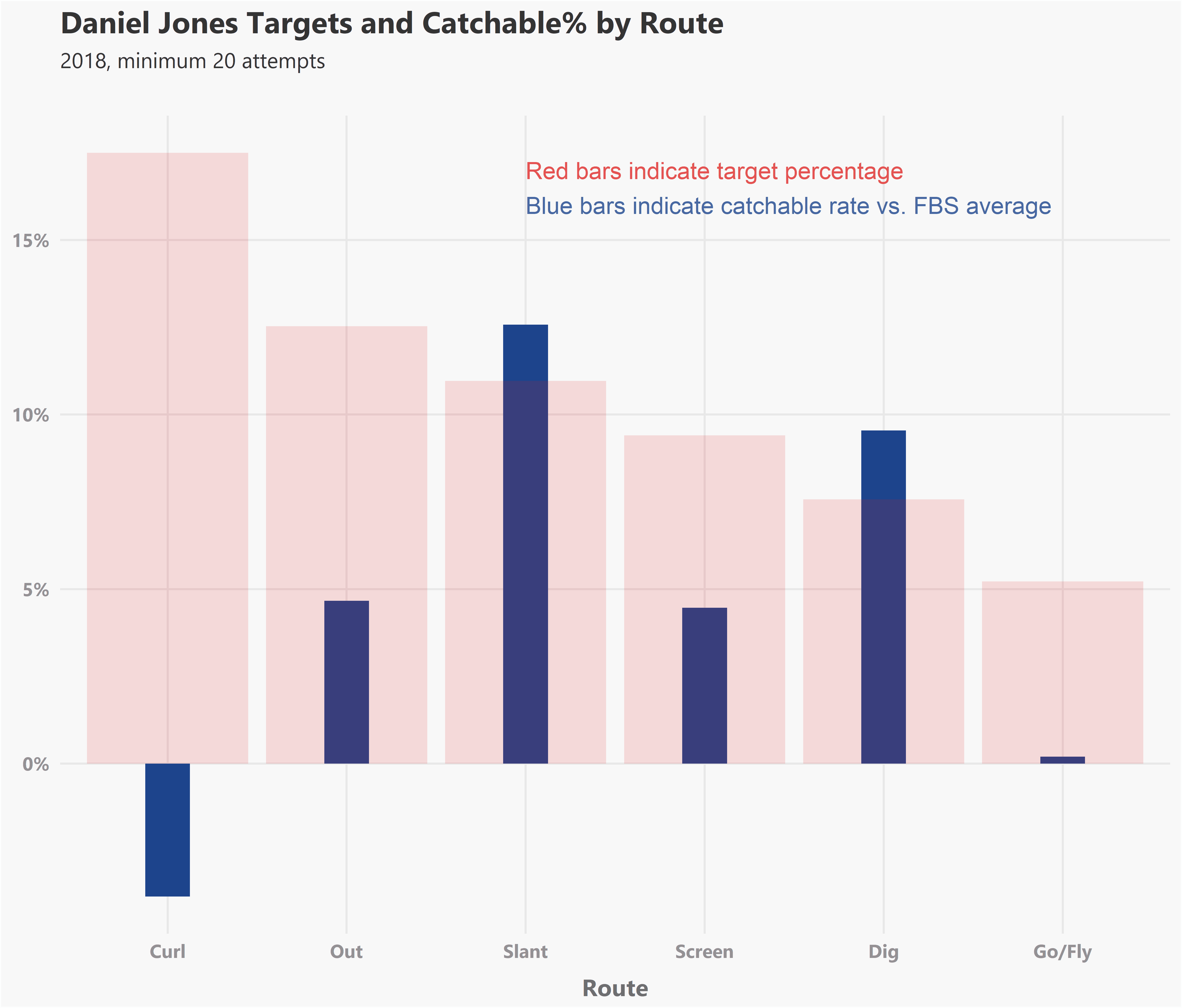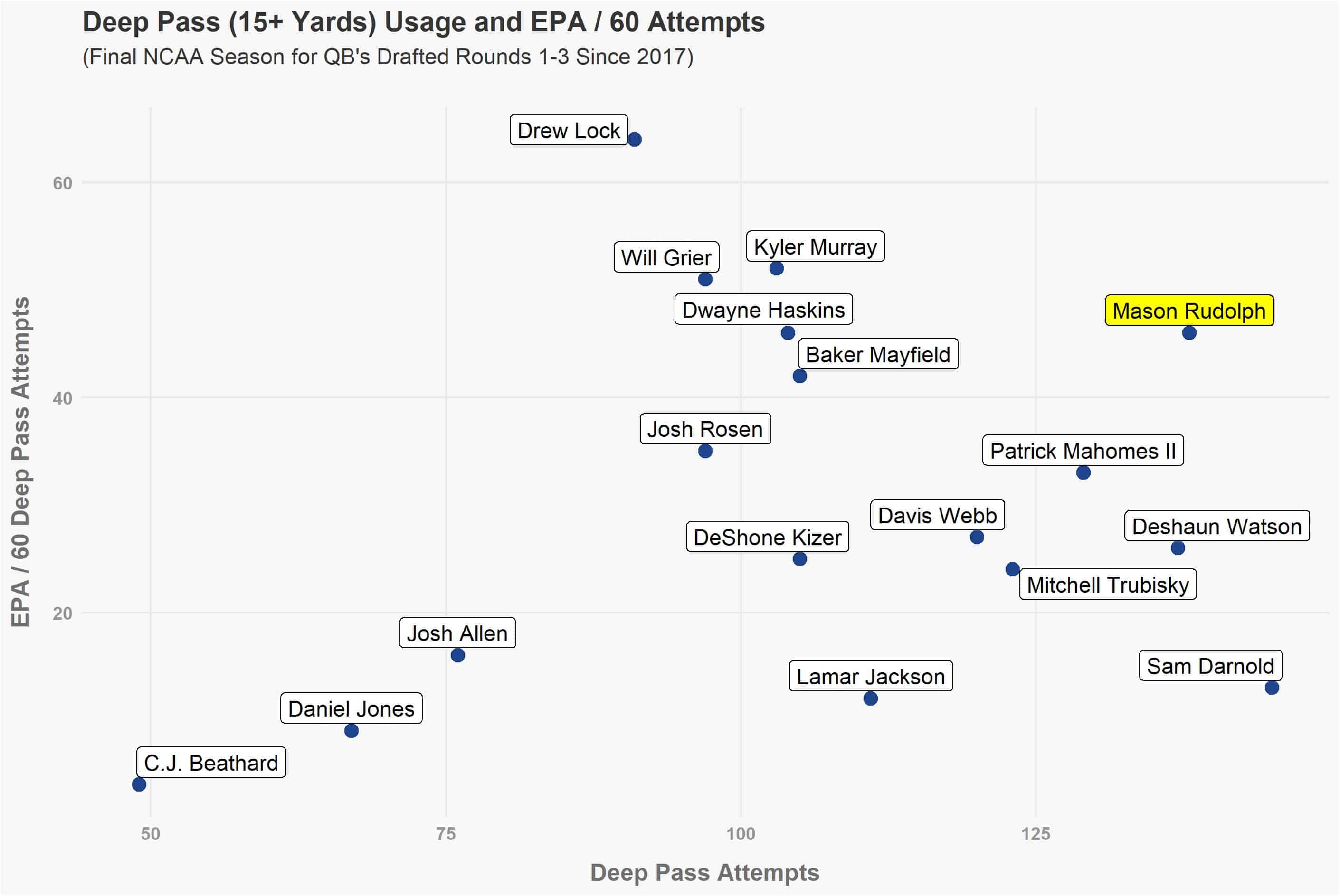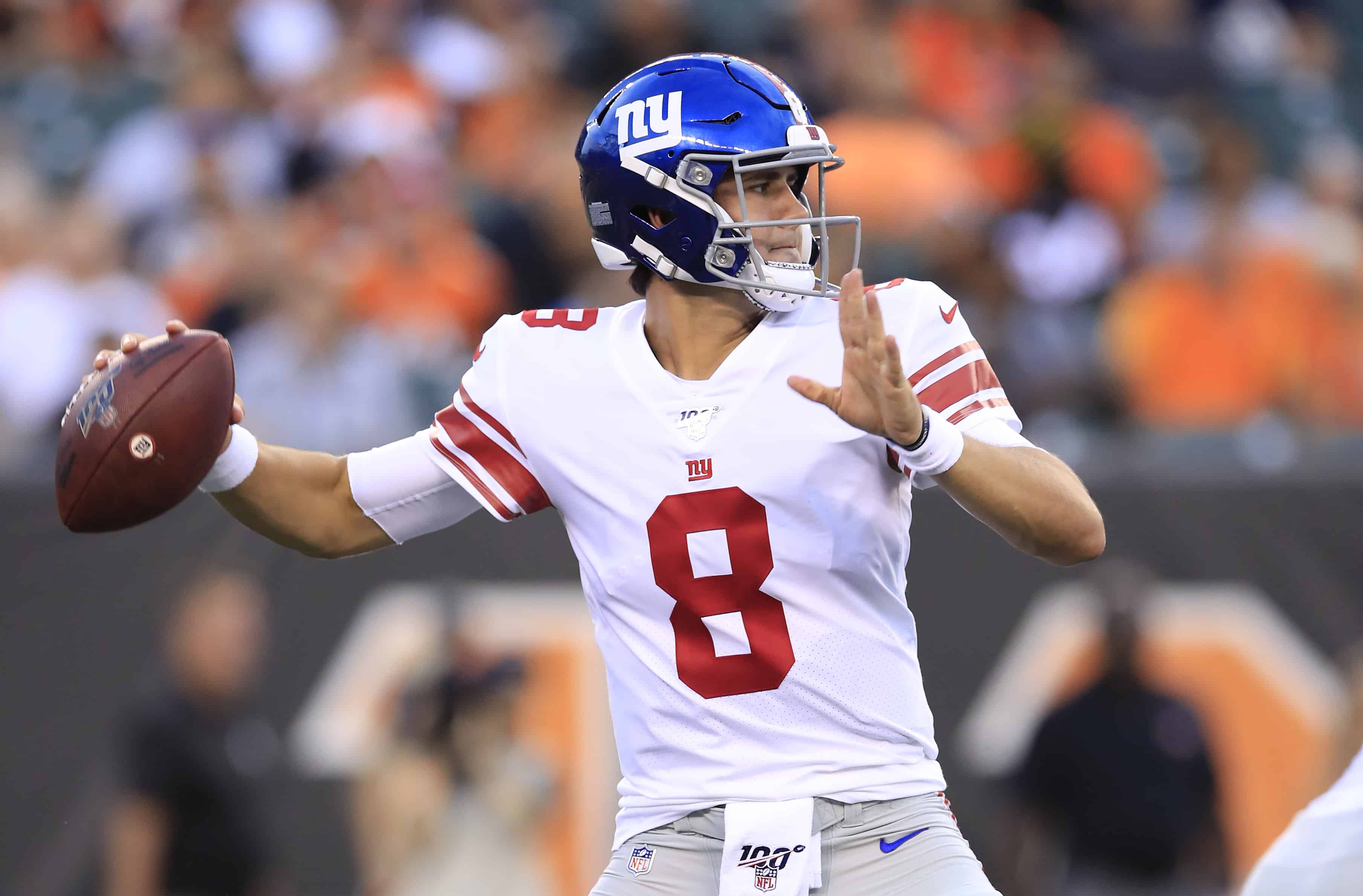Post also authored by Alex Vigderman, Sports Info Solutions

The changing of the guard at quarterback in the NFL was already well on its way with the likes of Patrick Mahomes, Deshaun Watson, Baker Mayfield, and Lamar Jackson all finding early success and bringing a new brand of football to the league. And now, two more teams who have spent the better part of the last two decades settled at quarterback find themselves relying on quarterbacks without a single NFL start under their belt.
With the news that Ben Roethlisberger will miss the rest of the season due to injury, and that the Eli Manning era in New York has finally come to an end, we will get our first look at two young quarterbacks, both of whom were polarizing in their own respects during the pre-draft process.
Daniel Jones
Daniel Jones steps into a starting role for a team with relatively low expectations. The Giants had top-ten picks in four of the last five seasons and were projected to be in a similar position this year regardless of when Jones took the helm.
He’s not a statue out there
Jones, the sixth overall pick in this year's draft, started three years at Duke in a relatively conservative spread offense that relied on him for his legs as well as his arm. He had over 100 designed runs in 2017, a figure that far exceeded his 2018 total of 53 but speaks to athleticism that can serve a young quarterback well in a pinch.
From purely a running perspective he's more similar to Josh Allen than guys like Lamar Jackson or Cam Newton, who represent the extremes of the types of running skills a quarterback can offer. Scheme and elusiveness drove Jones to solid rushing totals in college as opposed to elite speed or physicality. To that point, Jones ran a 4.81 40-yard dash at the combine and had one of the lowest broken tackle rates among quarterbacks last season.
He is used to short drops and quick hits
Along with using Jones's athleticism, Duke's offense was designed to help him get the ball out quickly. The Blue Devils used short (three-step or shorter) drops on over 80% of their dropbacks last season, which was well above the overall average of 73%. The Giants would be well-served to use a similar approach given the texture of their receiving corps, especially in a few weeks when the best receiver options are Golden Tate and Sterling Shepard, both of whom have had success on shorter routes from the slot in their careers.
Jones was probably at his best throwing slants or digs, which are bread-and-butter in-breaking routes in any short-pass-driven offense, albeit less so with the Giants. He threw slants third-most of all routes and posted an elite 88% catchable rate, which helped him to an Independent Quarterback Rating on slants that was third in the nation.

One possible trouble spot to watch out for would be hitting curls — the most commonly-targeted routes in football — consistently. Jones posted a below-average catchable throw rate on curls over the course of his career at Duke.
Despite the Duke offense's quick-hitting design, Jones was still put into a tough spot as a result of blocking failures. Duke offensive linemen, backs, and tight ends blew 7.4 blocks per 60 pass snaps, which was in the bottom 25 in the nation. That proved to be critical in how his 2018 season developed overall, as his 125 Independent Quarterback Rating (IQR) without pressure ranked 12th in the country (min. 100 clean-pocket attempts).
The Giants had sub-par blocking last year (they ranked 25th in SIS’ Blocking Total Points Earned), but they were better in the passing game (18th) than the running game (28th), and the group was retooled in the offseason, so there’s reason to believe Jones will have greater opportunity to work from structure in his rookie campaign.
He has a top-shelf back to lean on
In terms of the focus of the offense, though, it can't be ignored that Jones will have access to a weapon that is far beyond what he had at Duke — running back Saquon Barkley.
Jones only threw to running backs 37 times in 2018 with a middling IQR, so being able to maximize Barkley's value coming out of the backfield will be a new challenge. Eli Manning's third-most-targeted route/position combination in 2018 was flats to the running back, and while ideally the offense would be a little more aggressive than that, it is likely Jones will need to prove he can put the right mix of zip and touch on throws to backs.
Mason Rudolph
Former third-round pick Mason Rudolph has been thrust into a starting role due to Ben Roethlisberger’s elbow injury. After a stellar career at Oklahoma State, Rudolph gets his chance to prove he can be the heir apparent, and possibly save the Steelers’ season. The team apparently has confidence in the inexperienced signal-caller, as they just traded away next year’s first-round pick for defensive back Minkah Fitzpatrick. Let's take a look at what makes Rudolph an intriguing prospect and invokes confidence from the Steelers' front office.
He’s a Gunslinger
During his college career, Rudolph loved throwing the deep ball. His senior season Average Depth of Target (ADoT) of 11.9 yards was the highest of any QB drafted in the first three rounds since 2016. Not only did he throw it deep often, he also excelled at it. On throws 15 or more yards downfield, Rudolph had an EPA per 60 Attempts of 46. This ranked fifth among QB’s drafted in the first three rounds since 2016, but was notably higher than any QB with his level of deep pass attempts.

He has His Trusted Sidekick
Rudolph has the unique advantage of being a young backup QB with a built-in rapport with one of his receivers. James Washington, his favorite WR at Oklahoma State, has been with him during his entire college and NFL career. Look for the Steelers to potentially use Washington more often now that Rudolph is at QB. Also, watch for the pair to attempt to continue their college success on deep passes.
In 2017, Rudolph had an incredibly high ADoT of 18.5 yards on his 121 targets to Washington, which was good for the sixth-highest rate since 2016 of any QB-WR combo with at least 50 targets in a single season. This was due to Rudolph targeting Washington on 51 deep passes (4th) and resulted in an average Yards per Target of 12.9 (15th).
Rudolph-Washington Compared to QB-WR Combos w/ 50+ Targets in a Season (Since 2016)
| Number | Rank (Out of 760) | |
|---|---|---|
| Targets | 120 | 38th |
| Deep Targets | 51 | 4th |
| ADoT | 18.5 | 6th |
| Yds / Tgt | 12.9 | 15th |
The Steelers Potential Shift in Scheme
Over the past few seasons, the Steelers’ passing attack relied heavily on dynamic playmakers and a veteran QB running the show. Now, with an inexperienced QB and a receiving corps that hasn’t performed up to expectations so far this year, they might need to adjust their strategy.
Last season when Roethisberger led the league in both passing yards and attempts, he did so almost exclusively out of shotgun and without using play-action. The Steelers used shotgun on 92% of their dropbacks last season, which was the highest in the league and well above the league average of 80%. They used play-action on only 12% of their dropbacks, by far the lowest of any team and 12 percentage points lower than the league average rate. Even though this strategy of straight dropbacks purely from shotgun isn’t ideal for any offense, it did allow a veteran like Roethlisberger to read the field and get the ball to playmakers like JuJu Smith-Schuster and the since-departed Antonio Brown.
It would probably be best for them not to employ a similar strategy with Rudolph at QB. An increase in play-action should really benefit Rudolph. During his senior season in college, he used play-action on 47% of his dropbacks, the highest rate among any QBs drafted in the first three rounds over the last three seasons. On these drop backs he averaged an EPA per 60 Dropbacks of 26, which was an increase of 22 EPA per 60 Dropbacks from when he didn’t use play-action.
Final Word
Neither the Steelers or Giants are in ideal spots as they hand the reins over to their new starting quarterbacks. Fortunately, both Jones and Rudolph come with college pedigree that suggests they can handle the position, and their teams are likely to make the schematic changes around them that are important for their success. These two are a particularly interesting pair because of their disparate strengths and their teams’ unique circumstances so early in the season, so it will be fascinating to see how both teams progress through the 2019 season.
















